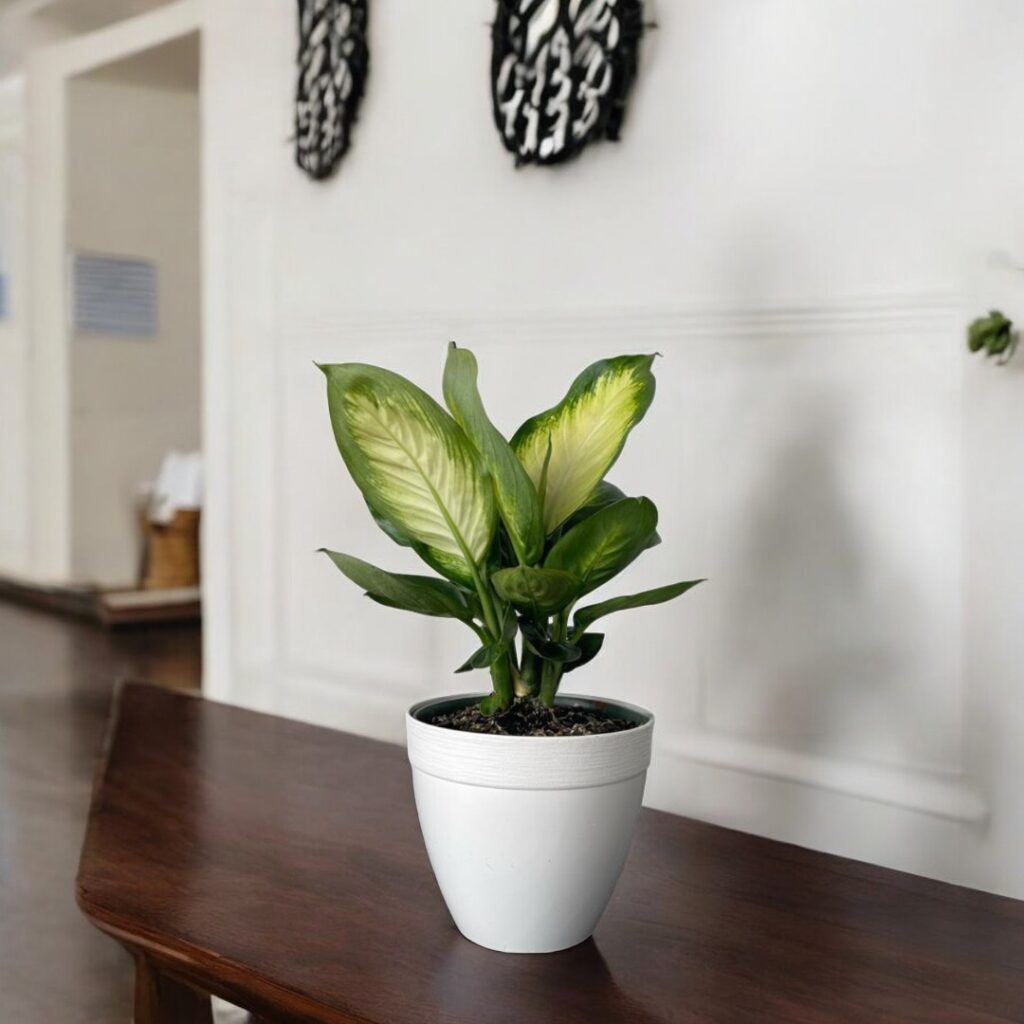Dieffenbachia Marianne
The Dieffenbachia Marianne is a stunning houseplant known for its dramatic, patterned leaves and its relatively easy-care nature. Often called “Dumb Cane” due to the toxic nature of its sap, this plant is a fantastic addition to any indoor space, especially if you’re looking for a bold statement piece. In this post, we’ll take a look at the key characteristics of the Dieffenbachia Marianne, its care requirements, and how to keep it looking its best.
What Makes the Dieffenbachia Marianne Special?
The Dieffenbachia Marianne is an eye-catching plant with broad, ovate leaves that feature vibrant green tones and stunning creamy-yellow variegation. The contrast between the dark green edges and the lighter, almost lime green center creates a beautiful pattern that can brighten up any room. Its large, lush foliage has a tropical, jungle-like feel, making it an excellent choice for creating a lively indoor garden.

The History and Types of Dieffenbachia Marianne
This plant grows in an upright, bushy manner and can reach up to 3 feet tall, depending on growing conditions. Its striking foliage combined with its relatively manageable size makes it perfect for adding height and a touch of drama to your home décor.
Dieffenbachia Marianne belongs to the Dieffenbachia genus, a group of tropical plants native to Central and South America. This genus was named after Ernst Dieffenbach, a 19th-century German botanist, and has since become one of the most popular indoor plants worldwide. Its journey from the tropical rainforests to homes and offices around the globe highlights its adaptability and timeless appeal. Historically, Dieffenbachia plants were valued not only for their ornamental beauty but also for their air-purifying qualities. Over the years, plant enthusiasts have bred different cultivars to emphasize specific features, such as unique leaf patterns, growth habits, and hardiness.
The Marianne variety stands out for its elegant foliage, characterized by creamy yellow centers bordered by dark green edges. Its leaves are slightly more delicate and light in appearance compared to some other Dieffenbachia types, making it a sophisticated choice for interior design. Beyond Marianne, the Dieffenbachia genus offers a wide range of types, each with distinct traits:
Dieffenbachia Camille
Known for its creamy white leaves with subtle green edges, this variety has a softer, pastel appearance and is popular for adding a calm, serene vibe to indoor spaces.Dieffenbachia Tropic Snow
This larger variety features bold, variegated leaves with splashes of white and green, making it a statement plant for spacious rooms.Dieffenbachia Compacta
A smaller, bushier type, perfect for tabletops or tight spaces. Its leaves are vibrant green with subtle white streaks.Dieffenbachia Seguine
Sometimes referred to as the “standard Dumb Cane,” this type boasts broader leaves with striking patterns and grows tall, making it ideal for corners or entryways.Dieffenbachia Reflector
This rare and eye-catching variety has dark green leaves speckled with bright neon green, creating a unique “reflective” look. It’s a favorite among collectors.Dieffenbachia Star Bright
True to its name, this cultivar features long, narrow leaves with a starburst-like pattern of light and dark green shades.
How to Care for Your Dieffenbachia Marianne
Though the Dieffenbachia Marianne is a low-maintenance plant, it does require certain conditions to thrive. Here’s a detailed guide on how to care for this beautiful tropical plant:
1. Light Requirements
The Dieffenbachia Marianne does best in bright, indirect light. Too much direct sunlight can scorch its delicate leaves, causing them to turn brown or yellow. On the other hand, low light can cause the plant to become leggy, and the beautiful variegation on the leaves may fade.
Ideally, place your Dieffenbachia Marianne in a location with bright, filtered light, such as near an east- or west-facing window. If the light is too low, the plant’s growth may slow, and it may not develop the vibrant leaf colors that make it so attractive.
2. Watering
The Dieffenbachia Marianne prefers consistently moist soil, but it doesn’t like to sit in water. Allow the top 1–2 inches of soil to dry out before watering. When you do water, ensure that the water drains freely from the bottom of the pot. Never let the plant sit in excess water, as this can lead to root rot.
In the winter, when the plant’s growth slows down, reduce watering. Be sure to monitor the soil moisture carefully and avoid overwatering during this period. Always check that the pot has drainage holes to allow any excess water to escape.
3. Humidity
Like many tropical plants, the Dieffenbachia Marianne enjoys a humid environment. Ideal humidity levels should be around 50% or higher. If you live in a dry climate or the air in your home tends to be dry (especially in winter), you can increase the humidity around the plant by misting it regularly, using a humidifier, or placing the pot on a humidity tray with pebbles and water.
If the plant’s leaves start to curl or develop brown tips, it may be a sign of too-low humidity. Keeping the plant in a more humid area can help it thrive.
4. Temperature
This plant prefers temperatures between 65°F and 75°F (18°C to 24°C). It should be kept in a warm environment and protected from cold drafts, air conditioners, and heating vents, which can cause stress. Avoid placing it in rooms with temperatures below 50°F (10°C), as this can stunt its growth and damage the leaves.
5. Soil
The Dieffenbachia Marianne prefers a well-draining potting mix. A peat-based potting mix works well, but you can also mix in some perlite or sand to improve drainage. The key is to avoid soil that becomes too compact or soggy, as this can lead to root rot.
Make sure the pot you use has drainage holes to allow any excess water to escape, which helps maintain healthy root systems.
6. Fertilizing
Feed your Dieffenbachia Marianne with a balanced, water-soluble fertilizer during the growing season (spring and summer). Dilute the fertilizer to half strength and apply once every 4 to 6 weeks. During the fall and winter, reduce fertilization, as the plant’s growth slows down during this time.
Over-fertilizing can cause the plant to grow too quickly, leading to weaker stems and less attractive foliage, so be mindful to follow the recommended dosage.
7. Pruning
To maintain the plant’s shape and encourage bushier growth, you can prune your Dieffenbachia Marianne. Trim back any yellowing or damaged leaves, as this will also help prevent the spread of potential diseases. Additionally, if the plant becomes too tall or leggy, you can cut back the stems to promote a fuller, more compact growth habit.
8. Repotting
The Dieffenbachia Marianne grows relatively quickly, and you may need to repot it every 1–2 years to give it more room to grow. Choose a pot that is just 1–2 inches larger in diameter than the current pot to avoid overwatering in a pot that is too large. Repotting is best done in the spring or early summer, when the plant is actively growing.
Why You Should Add a Dieffenbachia Marianne to Your Collection
The Dieffenbachia Marianne is an excellent plant for anyone looking to bring a touch of the tropics into their home. With its bold, variegated leaves and upright growth habit, it’s perfect for adding height and drama to your indoor garden. Plus, its relatively low maintenance and ability to thrive in typical indoor conditions make it a great choice for plant lovers of all experience levels.
Whether you’re looking to fill an empty corner or add greenery to a bookshelf, the Dieffenbachia Marianne will not disappoint. Its large, beautiful leaves will instantly transform your space and create a lush, vibrant atmosphere.
